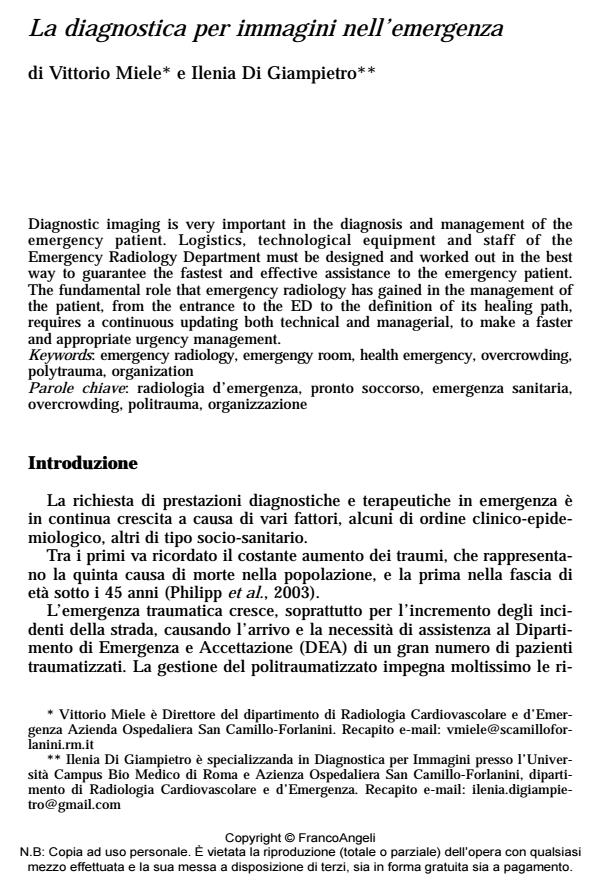La diagnostica per immagini nell’emergenza
Titolo Rivista SALUTE E SOCIETÀ
Autori/Curatori Vittorio Miele, Ilenia Di Giampietro
Anno di pubblicazione 2014 Fascicolo 2014/2 Lingua Italiano
Numero pagine 14 P. 128-141 Dimensione file 494 KB
DOI 10.3280/SES2014-002011
Il DOI è il codice a barre della proprietà intellettuale: per saperne di più
clicca qui
Qui sotto puoi vedere in anteprima la prima pagina di questo articolo.
Se questo articolo ti interessa, lo puoi acquistare (e scaricare in formato pdf) seguendo le facili indicazioni per acquistare il download credit. Acquista Download Credits per scaricare questo Articolo in formato PDF

FrancoAngeli è membro della Publishers International Linking Association, Inc (PILA)associazione indipendente e non profit per facilitare (attraverso i servizi tecnologici implementati da CrossRef.org) l’accesso degli studiosi ai contenuti digitali nelle pubblicazioni professionali e scientifiche
Diagnostic imaging is very important in the diagnosis and management of the emergency patient. Logistics, technological equipment and staff of the Emergency Radiology Department must be designed and worked out in the best way to guarantee the fastest and effective assistance to the emergency patient. The fundamental role that emergency radiology has gained in the management of the patient, from the entrance to the ED to the definition of its healing path, requires a continuous updating both technical and managerial, to make a faster and appropriate urgency management.;
Keywords:Emergency radiology, emergengy room, health emergency, overcrowding, polytrauma, organization
- Arfanakis K., Tamhane A.A., Pipe J.P., et al. (2005). K-space undersampling in propeller imaging. Magn Reson Med, 53: 675-83
- Wintermark M., Poletti P.A., Becker C.D. et al. (2002). Traumatic injuries: organization and ergonomics of imaging in the emergency environment. Eur Radiol, 12: 959-968
- ACR/AHA/ASE/ASNC/NASCI/SCAI/SCMR 2010 appropriate use criteria for cardiac computed tomography. A report of the American College of Cardio logy Foundation Appropriate Use Criteria Task Force, the Society of Cardiovascular Computed Tomography, the American College of Radiology, the American Heart Association, the American Society of Echocardiography, the American Society of Nuclear Cardiology, the North American Society for Cardiovascular Imaging, the Society for Cardiovascular Angiography and Interventions, and the Society for Cardiovascular Magnetic Resonance J Am Coll Cardiol, 56: 1864-1894
- Taylor A.J., Cerqueira M., Hodgson J.M., et al. (2010) ACCF/SCCT/
- Takakuwa K.M., Halpern E.J. (2008). Evaluation of a “triple rule-out” coronary CT angiography protocol: use of 64-section CT in low-to-moderate risk emergency department patients suspected of having acute coronary syndrome. Radiology, 248: 438-446
- Tan E.C., van Stigt S.F., van Vugt A.B. (2010) [Epub ahead of print]. Effect of a new pelvic stabilizer (T-POD ((R)) on reduction of pelvic volume and haemodynamic stability in unstable pelvic fractures. Injury
- Stengel D., Bauwens K., Schouli J. et al (2001). Systematic review and metanalysis of emergency ultrasonography for blunt abdominal trauma. Br J Surg, 88: 901-912
- Samad Z., Hakeem A., Mahmood S.S., et al. (2012). A meta-analysis and systematic review of computed tomography angiography as a diagnostic triage tool for patients with chest pain presenting to the emergency department. J Nucl Cardiol, 19: 364-376
- Raff G.L., Chinnaiyan K.M. (2009). The role of coronary CT angiography in triage of patients with acute chest pain. Rev Esp Cardiol, 62: 961-965
- Ptak T.H., Rhea J.T., Novelline R.A. (2001). Experience with a continuous, single-pass whole-body multidetector CT protocol for trauma: the tree-minute multiple trauma CT scan. Emerg Radiol, 8: 250-256
- Pohlenz O., Bode P.J. (1996). The trauma emergency room: a concept for handling and imaging the polytrauma patient. Eur J Radiol, 22: 2-6
- Philipp M.O., Kubin K., Hormann M. et al. (2003). Radiological emergency room management with emphasis on multidetector-row CT. Eur J Radiol, 48: 2-4
- Pereles F.S., McCarthy R.M., Baskaran V., et al. (2002). Thoracic aortic dissection and aneurysm: evaluation with non-enhanced true FISP MR angiography in less than 4 min. Radiology, 23: 270-4
- Mueller C.F., Yu J.S. (2002). The concept of a dedicated emergency radiology section: justification and blueprint. AJR, 179: 1129-1131
- Meijboom W.B., Mollet N.R., Van Mieghem C.A. et al. (2007). 64-Slice CT coronary angiography in patients with non-ST elevation acute coronary syndrome. Heart, 93: 1386-1392
- Krieg J.C., Mohr M., Ellis T.J., Simpson T.S. et al. (2005). Emergent stabilization of pelvic ring injuries by controlled circumferential compression: a clinical trial. J Trauma, 59, 3: 659-664
- Gruettner J., Fink C., Walter T., et al. Coronary computed tomography and triple rule out CT in patients with acute chest pain and an intermediate cardiac risk profile. Part 1: impact on patient management (2013). Eur J Radiol, 82: 100-105
- Grassi R., Romano L., Rotondo A. (2002). Emergency Departments. Radiol Med, 103: 351-358
- Chinnaiyan K.M., Goldstein J.A. (2009). Cardiac CT in the emergency department. Cardiol Clin, 27: 587-596
Vittorio Miele, Ilenia Di Giampietro, La diagnostica per immagini nell’emergenza in "SALUTE E SOCIETÀ" 2/2014, pp 128-141, DOI: 10.3280/SES2014-002011